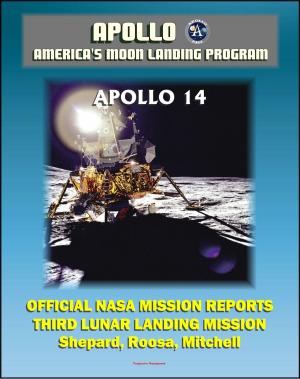Space Shuttle NASA Mission Reports: 1994 Missions, STS-60, STS-62, STS-59, STS-65, STS-64, STS-68, STS-66
Nonfiction, Science & Nature, Science, Physics, Astronomy, Other Sciences, History| Author: | Progressive Management | ISBN: | 9781466001480 |
| Publisher: | Progressive Management | Publication: | January 11, 2012 |
| Imprint: | Smashwords Edition | Language: | English |
| Author: | Progressive Management |
| ISBN: | 9781466001480 |
| Publisher: | Progressive Management |
| Publication: | January 11, 2012 |
| Imprint: | Smashwords Edition |
| Language: | English |
These official final program mission reports issued by the NASA Johnson Space Center cover missions in 1994: STS-60, STS-62, STS-59, STS-65, STS-64, STS-68, and STS-66. In these thorough reports, with information and specifics not available on NASA website mission descriptions, each orbiter system is reviewed in detail along with technical information on performance and anomalies.
STS-60: The primary objectives of the STS-60 mission were to deploy and retrieve the Wake Shield Facility-1 (WSF-1), and to activate the Spacehab-2 payload and perform on-orbit experiments. Secondary objectives of this flight were to activate and command the Capillary Pumped Loop/Orbital Debris Radar Calibration Spheres/Bremen Satellite Experiment/Getaway Special (GAS) Bridge Assembly (CAPL/ODERACS/BREMSAT/GBA) payload, the Auroral Photography Experiment-B (APE-B), and the Shuttle Amateur Radio Experiment-II (SAREX-II).
STS-62: The primary objectives of the STS-62 mission were to perform the operations of the United States Microgravity Payload-2 (USMP-2) and the Office of Aeronautics and Space Technology-2 (OAST-2) payload.
STS-59: The primary objective of the STS-59 mission was to successfully perform the operations of the Space Radar Laboratory-1 (SRL-1). The secondary objectives of this flight were to perform the operations of the Space Tissue Loss-A (STL-A) and STL-B payloads, the Visual Function Tester-4 (VFT-4) payload, the Shuttle Amateur Radio Experiment-II (SAREX-II) experiment, the Consortium for Materials Development in Space Complex Autonomous Payload-IV (CONCAP-IV), and the three Get-Away Special (GAS) payloads.
STS-65: The primary objective of this flight was to complete the operation of the second International Microgravity Laboratory (IML-2).
STS-64: The primary objective of this flight was to successfully perform the planned operations of the Lidar In-Space Technology Experiment (LITE), and to deploy the Shuttle Pointed Autonomous Research Tool for Astronomy (SPARTAN)-201 payload.
STS-68: The primary objective of this flight was to successfully perform the operations of the Space Radar Laboratory-2 (SRL-2).
STS-66: The primary objective of this flight was to accomplish complementary science objectives by operating the Atmospheric Laboratory for Applications and Science-3 (ATLAS-3) and the Cryogenic Infrared Spectrometers and Telescopes for the Atmosphere-Shuttle Pallet Satellite (CRISTA-SPAS).
These official final program mission reports issued by the NASA Johnson Space Center cover missions in 1994: STS-60, STS-62, STS-59, STS-65, STS-64, STS-68, and STS-66. In these thorough reports, with information and specifics not available on NASA website mission descriptions, each orbiter system is reviewed in detail along with technical information on performance and anomalies.
STS-60: The primary objectives of the STS-60 mission were to deploy and retrieve the Wake Shield Facility-1 (WSF-1), and to activate the Spacehab-2 payload and perform on-orbit experiments. Secondary objectives of this flight were to activate and command the Capillary Pumped Loop/Orbital Debris Radar Calibration Spheres/Bremen Satellite Experiment/Getaway Special (GAS) Bridge Assembly (CAPL/ODERACS/BREMSAT/GBA) payload, the Auroral Photography Experiment-B (APE-B), and the Shuttle Amateur Radio Experiment-II (SAREX-II).
STS-62: The primary objectives of the STS-62 mission were to perform the operations of the United States Microgravity Payload-2 (USMP-2) and the Office of Aeronautics and Space Technology-2 (OAST-2) payload.
STS-59: The primary objective of the STS-59 mission was to successfully perform the operations of the Space Radar Laboratory-1 (SRL-1). The secondary objectives of this flight were to perform the operations of the Space Tissue Loss-A (STL-A) and STL-B payloads, the Visual Function Tester-4 (VFT-4) payload, the Shuttle Amateur Radio Experiment-II (SAREX-II) experiment, the Consortium for Materials Development in Space Complex Autonomous Payload-IV (CONCAP-IV), and the three Get-Away Special (GAS) payloads.
STS-65: The primary objective of this flight was to complete the operation of the second International Microgravity Laboratory (IML-2).
STS-64: The primary objective of this flight was to successfully perform the planned operations of the Lidar In-Space Technology Experiment (LITE), and to deploy the Shuttle Pointed Autonomous Research Tool for Astronomy (SPARTAN)-201 payload.
STS-68: The primary objective of this flight was to successfully perform the operations of the Space Radar Laboratory-2 (SRL-2).
STS-66: The primary objective of this flight was to accomplish complementary science objectives by operating the Atmospheric Laboratory for Applications and Science-3 (ATLAS-3) and the Cryogenic Infrared Spectrometers and Telescopes for the Atmosphere-Shuttle Pallet Satellite (CRISTA-SPAS).















